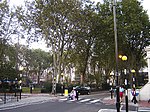Newington Green Unitarian Church

Newington Green Unitarian Church (NGUC) in north London is one of England's oldest Unitarian churches. It has had strong ties to political radicalism for over 300 years, and is London's oldest Nonconformist place of worship still in use. It was founded in 1708 by English Dissenters, a community of which had been gathering around Newington Green for at least half a century before that date. The church belongs to the umbrella organisation known as the General Assembly of Unitarian and Free Christian Churches, and has had an upturn in its fortunes since the turn of the millennium. Its most famous minister was Dr Richard Price, a political radical who is remembered for his role in the Revolution Controversy, a British debate about the French Revolution, but who also did pioneering work in finance and statistics. The most famous member of its congregation was Mary Wollstonecraft, who drew inspiration from Price's sermons in her work, both in arguing for the new French republic and in raising the issue of the rights of women. Wollstonecraft is commemorated by a mural in the church which has been described as "the birthplace of feminism".The building, which faces the north side of the green, was extended in 1860, and was listed in 1953. It lies within the London Borough of Hackney, although the rest of the green is part of the London Borough of Islington.
Excerpt from the Wikipedia article Newington Green Unitarian Church (License: CC BY-SA 3.0, Authors, Images).Newington Green Unitarian Church
Newington Green, London Canonbury (London Borough of Islington)
Geographical coordinates (GPS) Address External links Nearby Places Show on map
Geographical coordinates (GPS)
| Latitude | Longitude |
|---|---|
| N 51.55217 ° | E -0.08492 ° |
Address
Newington Green Unitarian Church
Newington Green 39A
N16 9PR London, Canonbury (London Borough of Islington)
England, United Kingdom
Open on Google Maps






